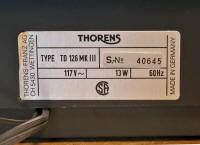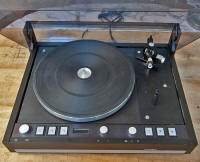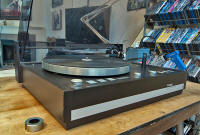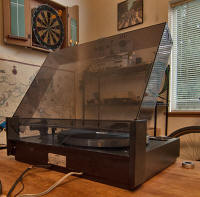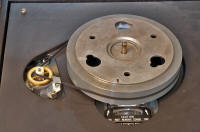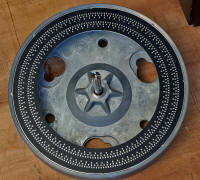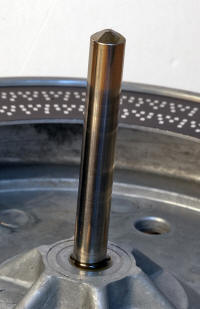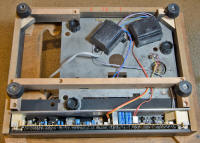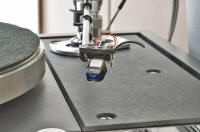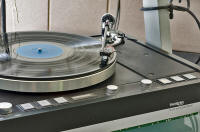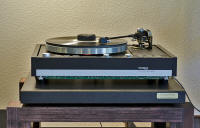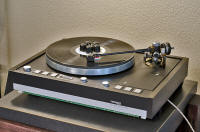-edible zone-
-- Date: March - 2024
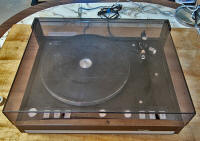 (click thumbnail to view full size)
(click thumbnail to view full size)
-- Looking backward to the beginning. It was January, 2013. I got an email from a reader in Colorado. The surviving daughter of the original owner. SN 40645. A Thorens TD126 mkIII. Basic black trim. (sn# indicates an early example) She couldn't find the arm wand for the TP16-III but, by her photos and descriptions, everything else was there. It had its original ship carton - a good sign.
-- Over email we reached an agreement on price with me paying for ship. I sent the money order. She sent the TD126. Fed-Ex got it to me. No mishaps.
-- Above and below are the "as received" photos circa 01-17-2013.
** Early Notes:
-- Purchased from private party January 2013. The TP63 armwand
is missing from the tonearm, which appears to be a TP16mkIII
Assembled for the first try. It switched on. It powered the platter spin. But the strobe window would not light up.
-- For the time being I will store this unit in
its factory ship carton and wait for two other projects to complete
before I examine the insides of this deck.
In the meantime, I'd like to collect as many product reviews (from back in the day) for this model as I can find.
-- Mfr dates: 1978 to ----- not sure when TD126-III production
halted. The history documents that I have don't indicate an end of
production date.
Below is a description of the drive system taken
from the owner's manual:
- 1 step belt drive
- DC motor with 72 pole tacho-generator
- speeds; 33-1/3, 45, 78 with electronic speed selection
- Motor speed control:
- Electronic regulation with load-correcting automatic pitch control
- Pitch control:
- ±6% illuminated stroboscope
- Wow & Flutter:0.035% per DIN 45.507
- Rumble un-weighted: 52 dB per DIN 45.539
- Rumble weighted: 72dB per DIN 45.539
*Date: 2015 / 2016
The process begins: TD126 early listening with a Zeta tonearm mounted.
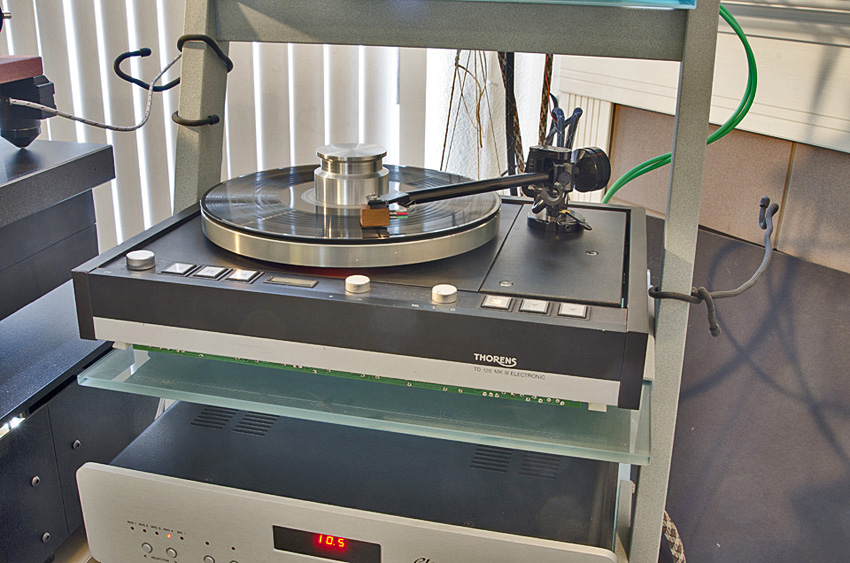
-- After the strobe mirror was glued back into place I found
that the TD126III as delivered to me was functional...except for the
missing armwand to the TP16 mkIII tonearm.
Having a few different
tonearms around I decided to mount the Zeta tonearm to this chassis. I
had a hunch that the Zeta might be a very good match to the TD126 except
that I lose all semi-auto features such as; end-of-play arm lift with
motor shut-off. And also the auto start function where one holds the
tonearm over the record and the motor automatically starts the platter
rotating. That's ok. I'm used to manual play turntables anyway.
There was a need to cut a new tonearm board to hold the Zeta. I used the
original Thorens armboard as a pattern to make the new one. And I
painted the new board textured black to match the rest of the turntable
appearance trim.
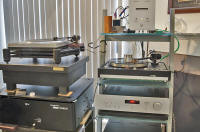 (click thumbnail for full size image)
(click thumbnail for full size image)
Above: image: Direct comparison; the SP10 mkII with a Thorens TD126-III Zeta. Although the Technics does have the minus-k.
-- In terms of sound qualities, the Technics SP10 mkII is another league higher than the TD126-III. Considered professional grade. Or at least it has been treated as such. Used in broadcast studios, including the BBC. And they were priced nearly three times higher than the TD126. We'll look closely at the TD126 build details in Part 2.
-- By the way, the glass shelving on the rack I'm using does not resonate at all. Very dead. Rap it with a blunt object and there is no ring. Just a thud. Although I do have drawings of alternate shelf brackets for this Furniture Works rack. But that is another adventure to explore.
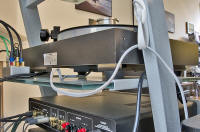 The bottom cover is off. I've got
large rubber feet using the same fastener holes that held the plastic
cover in place. It seems solid this way. Level too.
The bottom cover is off. I've got
large rubber feet using the same fastener holes that held the plastic
cover in place. It seems solid this way. Level too.
-- In this configuration I don't have to worry about arranging
an output orifice for the larger diameter phono cables to exit the
plinth. None of the original parts of this player will be modified or
compromised in any fashion. Everything's reversible.. But
definitely, I'm not crazy about the oem bottom cover design. I
think I'll study the work done by Rolf Kelch on the TD126 players he's
worked on. And, anyway, it gives me something to think about.
-- As seen in the above photos I did put this player to work a couple of years, or so, after I received it. At the time I had three TD124 players, one of which I would eventually keep.
-- Listening observations:
The Zeta tonearm aligned
readily using an arc protractor I had already drawn for that tonearm.
The cartridge mounted is a Denon DL-103R with Uwe Panzerholz body and an
SS ruby/fine-line stylus/cantilever set. I eye-balled vta so that the
bottom edge of the Uwe body appears parallel to the record surface below
it. A plausible starting point and not far from where I usually get my
fine tuning adjustments with this cartridge.
First record: Paul
Simon; There Goes Rhymin' Simon. A record I'm familiar with and a good
starting point to ascertain if my vta is in the ball park. It is. I was
greeted with the familiar sounds of the record as I like it, with plenty
of atmospheric glimmer and bloom. Detail levels seemed as high as I
normally get out of this arm and cartridge on the other record players
I've used them with. A good sense of rhythmic drive. Not bad for a
start. Then I played a Glen Gould piano rendition of Beethoven's 5th
symphony as transcribed by Franz Liszt for piano. A complete 5th
symphony performed at the piano. A nice listen. No wavering piano notes
were noticed.
Following the Gould/Beethoven I put on Brian
Auger's Oblivion Express; Closer To It!. A record with a high driving
rhythm component. Again, a good sense of driving rhythm.
More
later. My goal here is to decide if I want to go deep into this
restoration or not. So far what I've seen and heard shows promise.
__________________horizontal rule
*Date: 2016
-- TD126 early listening with an Infinity Black Widow tonearm and a Sonus Blue cartridge.
-- In every way that the BW tonearm with Sonus Blue cartridge sounds good, it continues to sound so on the TD126III. That said, I find the overall sound of the Pritchard designed Sonus Blue to be quite similar in character to the ADC XLM-II. Very clean and clear with accurate sounding highs.
__________________horizontal rule
*Date: 9/2017
--TD126 mkIII early listening using a Graham 2.2 tonearm with an ebony bodied DL-103R mounted.

-- Like before, I have that chintzy plastic bottom cover
removed so that I can more easily deal with phono cables of the
different tonearms I try on this turntable.
In use: TD126mkIII.
Bone stock and about 39 years old. From a cold start the platter
achieves a steady strobe pattern in slightly less than 3 revolutions.
After that the strobe stays rock solid throughout the listening session.
The electronics, no doubt, have some miles. And the electrolytics,
likely, have some deterioration. However old it may be, this thing still
runs nice. I don't expect to find anything alarming on the boards.
As it is in the photo, I like the sound I'm getting quite a lot. It
seems just as lively as with the Zeta tonearm, but the Graham tonearm
produces a greater bass weight in its sonic soundscape. With the Graham,
there is deep, deep bass. There is a very good sense of accurate pace.
Foot tapping, finger snapping tempos have that sense of energy. Very
quiet background. Good detail reproduction.
Changing records.
Cueing. Starting and stopping. It goes comfortably and conveniently. The
Graham does have some waggle about its uni-pivot as the arm gets handled
by its owner. One learns not to disturb the suspension of the player
while dropping the stylus into the record groove. I've had zero
miss-cues. It is not hard to manage.
*Date: January 2020
-- Early this year I decided to pull this player out of its factory ship carton again to use while I look underneath the TD124. The footer arrangement is the same as I have noted above from 2017. Also in use is the Neuance shelf as a support platform. The difference between this time and last can be seen in the passive pneumatic support system I have beneath the Neuance shelf. Actually it is really simple. I have three inner-tubes of the type used on hand trucks to fit 4 inch rims. I had found these inner-tubes at a local Home Depot many years previously. Some time was spent setting inflation psi equally in each tube to ensure that the Neuance shelf was level to planet Earth. Very little air pressure, actually. Just enough to float the shelf.
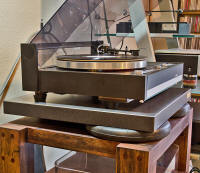 (click thumbnail for full image)
(click thumbnail for full image)
-- Summary: At this point I have given this player no real service, apart from returning a strobe mirror to its station, and making sure the motor had its lube. I did give it a new Thorens belt back in 2015, which to this date is holding up fine. This player has been reliable - apart from the 33 speed button that does not light, and also the auto-lift functions that have yet to be tested.
--End part one
* TD126-III Project Part 2 (disassembly and analysis)
